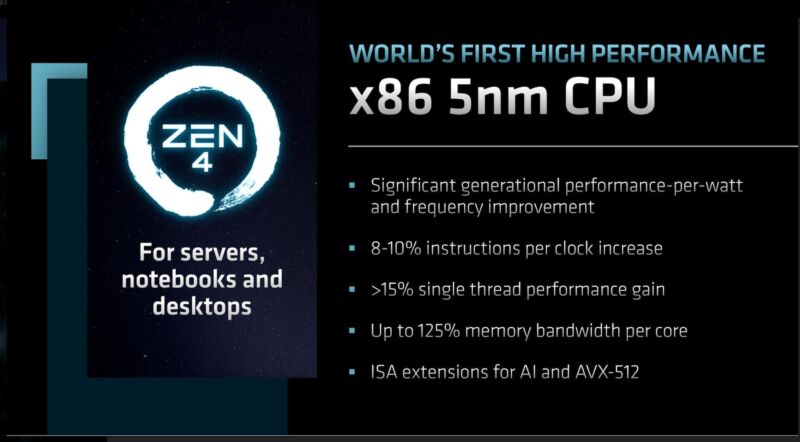CPUs based on AMD’s new Zen 4 architecture won’t arrive until this fall, but the company is already dropping hints about what comes next. As reported by AnandTech, AMD is planning a new Zen 5 architecture, which is scheduled to come to desktop and laptop PCs in 2024. The company is also planning to bring the Zen 4 architecture to laptops in 2023, while the desktop CPUs remain on track to launch in 2022.
AMD also provided more information about Zen 4’s performance. The company said at Computex that the Ryzen 7000-series chips would sport roughly 15 percent faster single-threaded performance than Ryzen 5000. The company said Friday that Zen 4 was between 8 and 10 percent faster than Zen 3 at the same clock speeds, accounting for most of the speed improvement, while the remaining 5 to 7 percent will come from higher clock speeds for Ryzen 7000 CPUs. Zen 4 can also deliver roughly 25 percent higher performance-per-watt than Zen 3.
The company will bring back its 3D V-Cache technology for some Zen 4 CPUs as well. This allows AMD to stack additional L3 cache on top of the CPU die, providing a big boost to the amount of cache without increasing the footprint of the CPU die or the CPU package. As we saw in our review of the Ryzen 7 5800X3D, the technology helps with game performance in particular, though the chip also ran a bit hotter than Zen 3 CPUs without 3D V-Cache, and its somewhat lower clock speeds made it perform a bit worse in non-gaming workloads.
We didn’t know whether 3D V-Cache would be a feature of all Zen 4 CPUs, but AMD’s slide makes it clear that there will be Zen 4 CPUs available with and without the extra cache. As with the 5800X3D, the chips with 3D V-Cache will presumably be targeted primarily at gamers since those are the apps that benefit the most directly.
As for the Zen 4-based laptop chips coming next year, AMD’s laptop processors have always been a bit different from their desktop CPUs, with monolithic chip designs instead of chiplet-based designs and high-performance integrated GPUs included across the board. But their laptop and desktop CPU lines have diverged more in recent years—Ryzen 6000 laptop CPUs combine a 6 nm revision of Zen 3 called “Zen 3+” and an integrated GPU based on the RDNA2 architecture. That will continue for the Zen 4 laptop CPUs, which will be manufactured on a 4 nm process instead of the desktop chips’ 5 nm process and will include an RDNA3-based GPU.
Swapping Ryzen 6000’s RDNA2 GPU for an RDNA3 GPU so quickly shows that AMD is committed to improving its integrated graphics performance. AMD’s Ryzen laptop CPUs were paired with some version of the company’s aging Vega GPU architecture for years, and it’s nice to see that we won’t be saddled with RDNA2-integrated GPUs long after AMD’s dedicated GPUs have moved past it.
AMD also shared a handful of GPU-related details, confirming a chiplet-based design for at least some of its next-gen 5 nm RDNA3 GPUs and scheduling RDNA4 for 2024 (on an as-yet-undisclosed “advanced node”). The company says that RDNA3 GPUs will provide 50 percent more performance per watt than RDNA2, thanks to a combination of the new 5 nm manufacturing process and architectural improvements.

